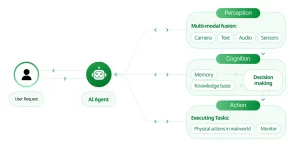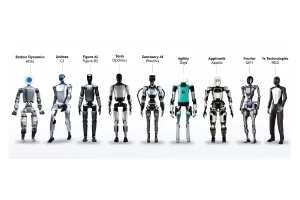Bipedal humanoid robots are no longer confined to science fiction. In 2025, these machines are increasingly integrated into industries, public spaces, and even entertainment. With significant strides in artificial intelligence, mechanical design, and real-world applications, humanoid robots are poised to become integral to our daily lives.
Top Bipedal Humanoid Robots of 2025
- Figure 02 & Helix – Figure AI (USA)
- Figure 02: Equipped with 16 degrees of freedom (DOF) hands, NVIDIA-powered vision-language AI, and conversational capabilities, tested in BMW factories.
- Helix: Features 35 DOF and a dual-system AI (Helix VLA) capable of controlling two robots simultaneously.
- Optimus Gen 2 – Tesla (USA)
- Showcases smoother movements, including dancing and pouring drinks.
- Aims for mass production by 2026, targeting a price range between $20,000–$30,000.
- Atlas (Electric Version) – Boston Dynamics (USA)
- Transitioned from hydraulic to fully electric in 2024.
- Offers enhanced strength and a broader range of motion, designed for real-world industrial applications.
- Digit – Agility Robotics (USA)
- Actively deployed in warehouses, such as GXO Logistics in Georgia.
- Capable of lifting up to 16 kg and navigating complex environments.
- Apollo – Apptronik (USA)
- A general-purpose humanoid robot standing 1.73 meters tall.
- Designed for tasks ranging from elderly care to factory work, with AI learning capabilities.
- G1 – Unitree Robotics (China)
- Priced at $16,000, making it one of the most affordable humanoid robots.
- Equipped with 23 powered joints, capable of walking at over 4.4 mph, climbing stairs, and performing tasks like soldering and cooking.
- GR-2 – Fourier Intelligence (China)
- An upgrade from the GR-1, standing at 1.75 meters and weighing 63 kg.
- Features 53 degrees of freedom, a detachable battery, and enhanced vision for real-time mapping and obstacle avoidance.
- SE01 – Engine AI (China)
- A full-size humanoid robot with 32 degrees of freedom, capable of walking at 2 m/s, squatting, grasping, and even performing a front flip.
- Debuted at the 2025 CCTV New Year’s Gala.
- RAISE A1 & Yuanzheng A2 – AgiBot (China)
- RAISE A1: Stands at 1.75 meters, weighs 53 kg, and can handle loads up to 80 kg.
- Yuanzheng A2: Designed for delicate tasks like threading a needle, showcasing high precision.
- NEO Beta – 1X Technologies (Norway)
- A prototype bipedal humanoid designed for home use, focusing on tasks like tidying and organizing.
- Utilizes Nvidia’s Isaac GR00T N1 model for autonomous operations.
Humanoid Robots in Real-World Scenarios
Beijing Half-Marathon: A Test of Endurance
In April 2025, Beijing hosted the world’s first half-marathon featuring humanoid robots. Twenty-one robots from companies like Noetix Robotics and Unitree Robotics participated, with Tien Kung Ultra completing the race in 2 hours and 40 minutes. This event highlighted the advancements and challenges in robotic locomotion.
China’s Integration of Embodied AI
China is increasingly integrating “embodied AI” technologies into daily life. In cities like Shenzhen, drones deliver food autonomously, and humanoid robots are gaining attention, with companies like Unitree showcasing their potential at widely viewed events. China’s leadership is prioritizing AI and robotics to tackle demographic issues, revitalize the tech sector, and compete with the US, especially in light of ongoing trade tensions and semiconductor sanctions.
The Future of Humanoid Robotics
The advancements in bipedal humanoid robots signify a transformative period in robotics. As these machines become more integrated into various sectors, from manufacturing to healthcare, they promise to reshape our interaction with technology. With continued innovation and ethical considerations, humanoid robots are set to become indispensable partners in our daily lives.


